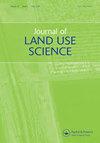马拉维中部农民恢复决策和投资的景观规模效应:基于主体的建模方法
IF 3.3
4区 环境科学与生态学
Q1 AGRICULTURE, MULTIDISCIPLINARY
引用次数: 1
摘要
摘要资源恢复政策越来越强调当地农民的参与和贡献。然而,对农民主导的恢复对环境影响的经验背景理解仍然很少。使用六个集成多类型数据的基于Agent的建模(ABM)模拟,我们探索了马拉维中部地方恢复行动的潜在时空聚集模式和结果。研究结果揭示了10年的积极趋势和空间上明确的潜在恢复程度和强度、绿色度和土地生产力,所有这些都因农民的参与水平而异。景观再绿化是适度有希望的,绿色水平波动,土地生产力水平低,略有增加,然后稳定。研究结果还表明,适当的激励措施、恢复知识和激励地方领导层是促进地方恢复的有利管理选择。将这些有利的管理和政策选项捆绑在一起将最大限度地实现本地恢复。研究结果表明,赋予自下而上的恢复工作以增强环境影响。我们还展示了使用ABM为空间目标、循证恢复政策的实施和监测提供见解的潜力。本文章由计算机程序翻译,如有差异,请以英文原文为准。
Landscape-scale effects of farmers’ restoration decision making and investments in central Malawi: an agent-based modeling approach
ABSTRACT Local farmers’ engagement and contributions are increasingly underscored in resources restoration policy. Yet, empirical context-situated understanding of the environmental impacts of farmer-led restoration remains scant. Using six Agent-based Modeling (ABM) simulations that integrate multi-type data, we explore the potential spatial-temporal aggregate patterns and outcomes of local restoration actions in Central Malawi. Findings uncover a 10-year positive trend and spatially explicit potential restoration extent and intensity, greenness, and land productivity, all varying by farmer’s participation level. Landscape regreening is modestly promising with fluctuating greenness levels and low, slightly incremental, then steady land-productivity levels. Findings also show appropriate incentives, restoration knowledge, and inspiring local leadership as propitious management options for boosting local restoration. Bundling these enabling management and policy options would maximize local restoration. Findings suggest empowering bottom-up restoration efforts for enhanced environmental impacts. We also demonstrate the potential of using ABM to offer insights for spatially targeted, evidence-based restoration policy implementation and monitoring.
求助全文
通过发布文献求助,成功后即可免费获取论文全文。
去求助
来源期刊

Journal of Land Use Science
Environmental Science-Management, Monitoring, Policy and Law
CiteScore
5.40
自引率
6.20%
发文量
26
期刊介绍:
The Journal of Land Use Science provides a central outlet for high-quality articles on theoretical and empirical aspects of land-use science at the interface of social and environmental systems. The Journal brings together an array of research perspectives at multiple temporal, spatial and social scales that contribute a better understanding of land-system dynamics and communicate scientific advances towards attaining land-system sustainability.
 求助内容:
求助内容: 应助结果提醒方式:
应助结果提醒方式:


